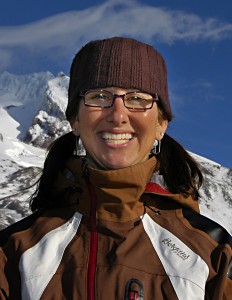 by Linda Cowan, Spring 2010
by Linda Cowan, Spring 2010
A few weeks ago when skiing with a group of students, I was struck by the notion that although I knew these students had been taught movement patterns necessary for effective and efficient skiing, I saw little execution of these movements when we were warming up. At first I thought, well, it’s just our first run, perhaps they were still waking up and I should just move on, but this led me to evaluate my role as their instructor. I can teach movement patterns all day long, but how can I get these students to own this information? These students can do movement patterns when asked, but how can I get them to voluntarily choose these movements on their own? My role as an instructor is not only to teach, model, guide and give specific feedback but to also lead my students to the ownership of information so that they will know when, where and why they should apply different movement patterns. I then determined that today’s lesson would focus on the ownership of a movement pattern we’d been working on for the past 3 weeks.
This led me to think about how to spend our time together that day. How could I better ensure their application of movements essential to good skiing? Now granted, these students are experienced. They can ski the entire mountain, and they’re motivated to learn because they ski race, but that doesn’t change a necessary outcome for all students-ownership of information.
First, I knew that we could walk through a lesson on alignment. For example, we could spend the morning focusing on our upper and lower body alignment through turn transition, and spend time applying this skill in different environments/terrain, but my goal was broader than these experiences themselves, my goal was a deeper understanding of why and a conviction for their movements given the desired outcome, terrain and snow conditions. I wanted them to own what to do, when, where and why.
So, I decided to use science to help us build our efficient skiing convictions. Since I teach fifth grade, we tackle the topic of Variables. We take a scenario, change one variable and study the outcome. Then, we change a different variable, and compare the two experiments. These simple experiments help students to see how scientists can study problems and learn from the outcome of different experiments. Sure, I could have chosen to run the group through a battery of drills, terrain challenges, and talked through the sensations and feedback they were receiving from their skis and movements, but they need to own this information for themselves. So, we became scientists.
To get buy-in, we talked as a group about what we’d been working on the past few weeks. We agreed to study the alignment of our hips through turn transition. So, as a group, we decided to fi nish each turn by squaring up our hips to our skis before starting our next turn. We wanted to see what outcome was achieved with this movement. Our conversations went as follows:
”I felt my tails wash out at the finish of each turn.”
“I found it hard to start the next turn because I wasn’t facing the right direction.”
So, we then agreed that on our next lap (same terrain so that we were careful to change only one variable) we would be mindful of our legs turning in our hip sockets, and through turn transition, work to keep our hips more aligned to our intended direction of travel through turn transition instead of squaring up to our skis. Our next conversation went as follows:
“I felt better prepared for the upcoming turn because of the discipline of my hips and upper body.”
“I was surprised how this focus helped me to move my weight to my outside ski through turn completion.”
This conversation was directed and led by the students, not by me. If ever they seemed to get stuck, we’d extend the distance or add varied terrain to help feel sensations that they could then put to words. These students ranged from 8 -13 years of age, yet, they were talking like both scientists AND skiers. They now had a reason to focus on the alignment of their hips through turn transition, because they better understood the outcome of not doing so.
When we came out after lunch our lesson changed gears. At the top of each run, students were asked to state the movements they wanted to focus on, where in each turn and why. As a result, the skiing from the group began to change. Each student started skiing with conviction, purpose and intention. They were making the decisions, and learning about the outcomes and beginning to own the information from our morning ‘sciencing lesson’ for themselves.
Of course, our first role as instructors is to teach, model, guide, and give specific feedback to help all of our students learn, but eventually, our students need guidance towards owning the information we’ve been teaching, modeling and guiding them through all season.
Whether teaching two-hour classes, one-day or multi-week programs, it is our responsibility to help our students own the information we’ve taught, modeled and given them feedback on, and perhaps in the future, a “sciencing lesson” might provide the vehicle for students to take on and own the information you worked so hard to communicate to them.
